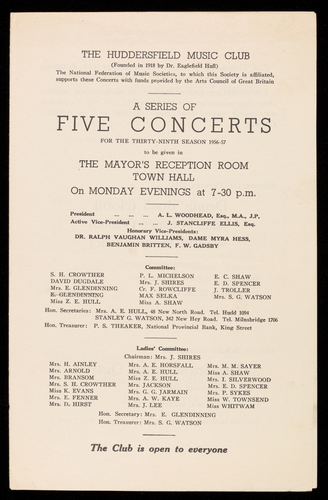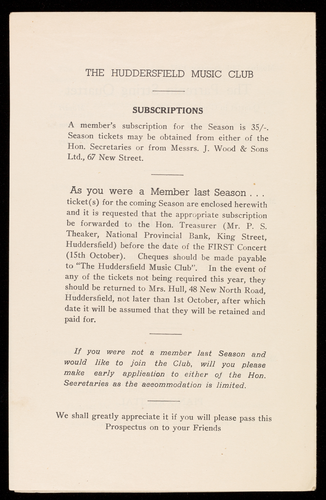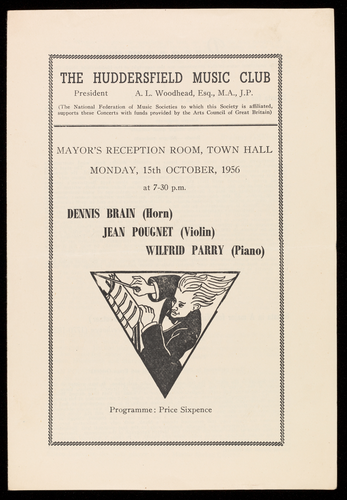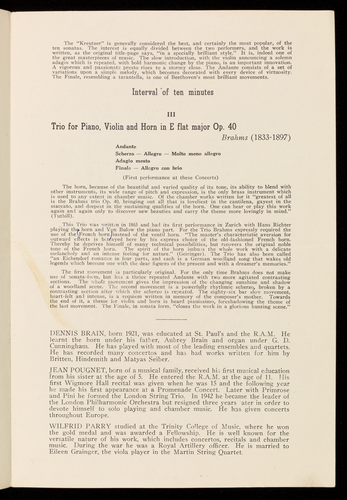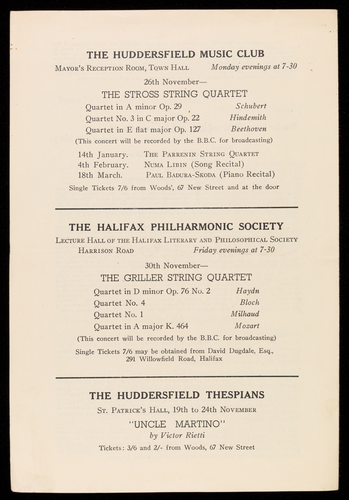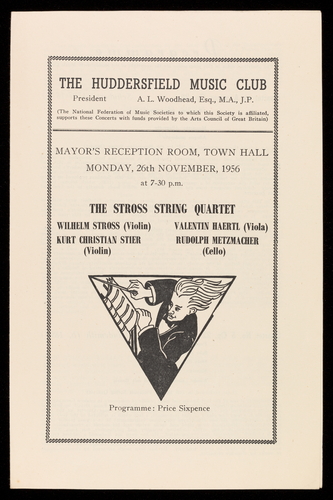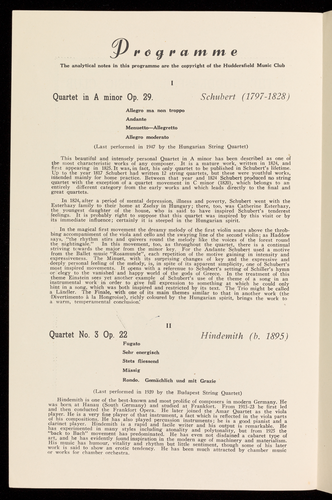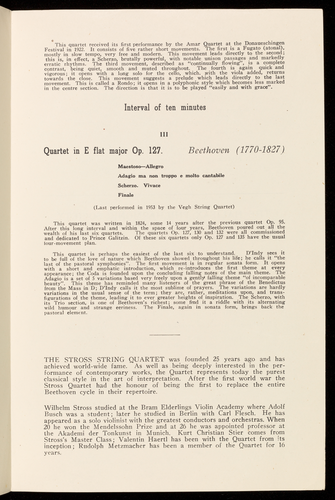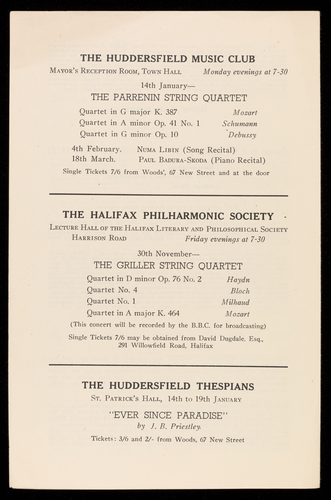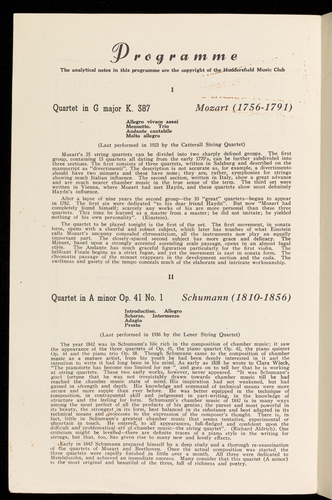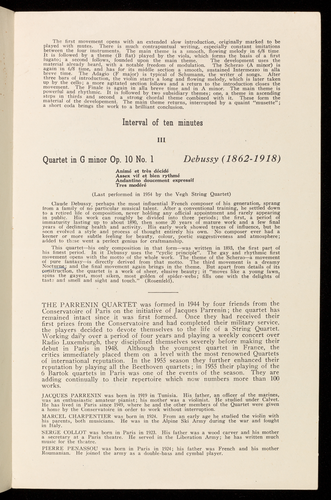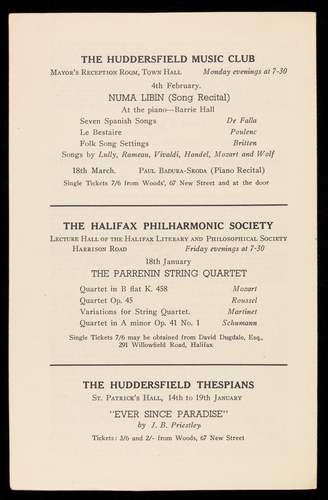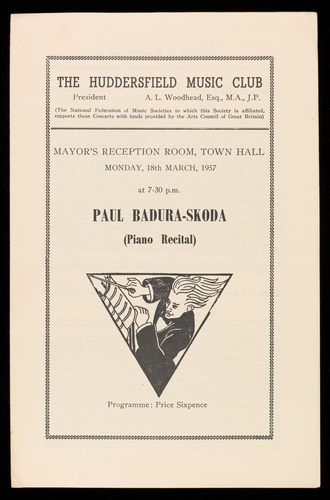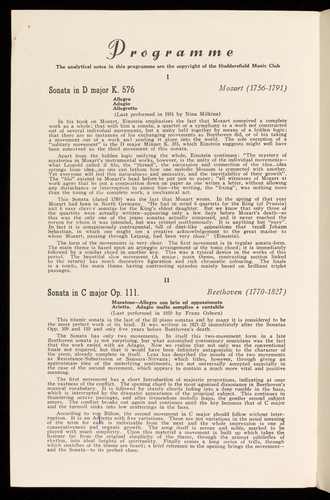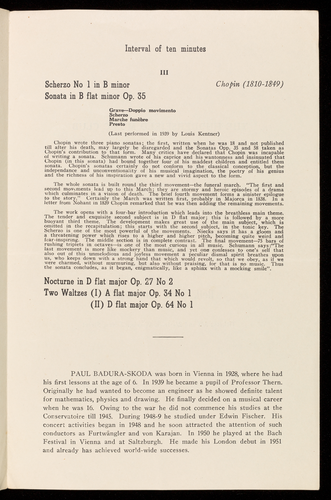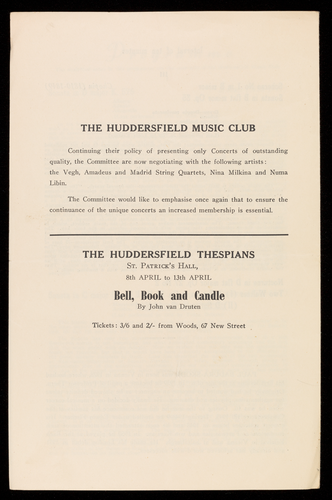Ocr'd Text:
THE HUDDERSFIELD MUSIC CLUB
(Founded in 1918 by Dr. Eaglefield Hull)
The National Federation of Music Societies, to which this Society is affiliated,
supports these Concerts with funds provided by the Arts Council of Great Britain
A SERIES OF
FIVE CONCERTS
FOR THE THIRTY-NINTH SEASON 1956-57
to be given in
THE MAYOR'S RECEPTION ROOM
TOWN HALL
On MONDAY EVENINGS at 7-30 p.m.
A. L. WOODHEAD, Esq., M.A., J.P,
J. STANCLIFFE ELLIS, Esq.
Honorary Vice-Presidents:
DR. RALPH VAUGHAN WILLIAMS, DAME MYRA HESS,
BENJAMIN BRITTEN, F. W. GADSBY
President
Active Vice-President
S. H. CROWTHER
DAVID DUGDALE
Mrs. E. GLENDINNING
E. GLENDINNING
Miss Z. E. HULL
...
Mrs. H. AINLEY.
Mrs. ARNOLD
Mrs. BRANSOM
Mrs. S. H. CROWTHER
Miss K. EVANS
Mrs. E. FENNER
Mrs. D. HIRST
Committee:
P. L. MICHELSON
Mrs. J. SHIRES
Cr. F. ROWCLIFFE
MAX SELKA
Miss A. SHAW
Hon. Secretaries: Mrs. A. E. HULL, 48 New North Road. Tel. Hudd 1094
STANLEY G. WATSON, 342 New Hey Road. Tel. Milnsbridge 1706
Hon. Treasurer: P. S. THEAKER, National Provincial Bank, King Street
E. C. SHAW
E. D. SPENCER
J. TROLLER
Mrs. S. G. WATSON
Ladies' Committee:
Chairman: Mrs. J. SHIRES
Mrs. A. E. HORSFALL
Mrs. A. E. HULL
Miss Z. E. HULL
Mrs. JACKSON
Mrs. G. G. JARMAIN
Mrs. A. W. KAYE
Mrs. J. LEE
Mrs. M. M. SAYER
Miss A. SHAW
Mrs. I. SILVERWOOD
Mrs. E. D. SPENCER
Mrs. P. SYKES
Miss W. TOWNSEND
Miss WHITWAM
Hon. Secretary: Mrs. E. GLENDINNING
Hon. Treasurer: Mrs. S. G. WATSON
The Club is open to everyone
Ocr'd Text:
The Committee is happy to announce the following
Season of outstanding Chamber Music Concerts.
The artists engaged at four of the concerts are making
their first appearance in Huddersfield, and the Committee
confidently expect that much interest will be created
thereby.
MONDAY, 15th OCTOBER, 1956
Dennis Brain (Horn)
Jean Pougnet (Violin)
Wilfrid Parry (Piano)
Programme includes:
Sonata in A major (Kreutzer)
Horn Trio in E flat, Op. 40
MONDAY, 26th NOVEMBER, 1956
Beethoven
Brahms
The Stross String Quartet
Quartet in A minor, Op. 29
Quartet No. 3 in C major, Op. 22
Quartet in E flat major, Op. 127
Schubert
Hindemith
Beethoven
Ocr'd Text:
MONDAY, 14th JANUARY, 1957
The Parrenin String Quartet
Quartet in G major, K. 387
Quartet in A minor
Quartet
MONDAY, 4th FEBRUARY, 1957
At the Piano.
MONDAY, 18th MARCH, 1957
Numa Libin
SONG RECITAL
Songs by Handel, Bononcini, Gluck, Ravel, Ibert,
Poulenc, de Falla, Finzi, Vaughan Williams,
and Operatic Arias
Mozart
Schumann
Paul Badura-Skoda
PIANO RECITAL
Debussy
BARRIE HALL
Programme to be announced later.
Ocr'd Text:
THE HUDDERSFIELD MUSIC CLUB
SUBSCRIPTIONS
A member's subscription for the Season is 35/-.
Season tickets may be obtained from either of the
Hon. Secretaries or from Messrs. J. Wood & Sons
Ltd., 67 New Street.
As you were a Member last Season .
ticket (s) for the coming Season are enclosed herewith
and it is requested that the appropriate subscription.
be forwarded to the Hon. Treasurer (Mr. P. S.
Theaker, National Provincial Bank, King Street,
Huddersfield) before the date of the FIRST Concert
(15th October). Cheques should be made payable
to "The Huddersfield Music Club". In the event of
any of the tickets not being required this year, they
should be returned to Mrs. Hull, 48 New North Road,
Huddersfield, not later than 1st October, after which
date it will be assumed that they will be retained and
paid for.
If you were not a member last Season and
would like to join the Club, will you please
make early application to either of the Hon.
Secretaries as the accommodation is limited.
We shall greatly appreciate it if you will please pass this
Prospectus on to your Friends
Ocr'd Text:
THE HUDDERSFIELD MUSIC CLUB
A. L. Woodhead, Esq., M.A., J.P.
(The National Federation of Music Societies to which this Society is affiliated,
supports these Concerts with funds provided by the Arts Council of Great Britain)
President
MAYOR'S RECEPTION ROOM, TOWN HALL
MONDAY, 15th OCTOBER, 1956
at 7-30 p.m.
DENNIS BRAIN (Horn)
JEAN POUGNET (Violin)
WILFRID PARRY (Piano)
100
Programme: Price Sixpence
Ocr'd Text:
Progra
rogramme
The analytical notes in this programme are the copyright of the Huddersfield Music Club
I
Sonata for Horn and Piano in F major Op. 17
Allegro moderato
Poco adagio quasi andante
Rondo - Allegro moderato
(First performance at these Concerts)
Beethoven cultivated three distinct forms of chamber music; first, wind instruments
supported by piano or strings; second, piano and strings; third, strings alone. The start of all
three was almost contemporaneous but the course of their development varied. He discarded
the first group after 1800 and thereafter used wind instruments for orchestral music onl
The
second group persisted until 1815; the final group-strings alone-kept Beethoven's interest
until the end of his life. The Horn Sonata and the Septet in E flat were both written in 1800
and were therefore the last of Beethoven's compositions to make use of wind instrument in
chamber music. All the duo sonatas were written as brilliant virtuoso concert pieces in
marked contrast to the other chamber music, in which virtuosity as an end in itself is excluded.
The Horn Sonata is no exception to the rule. Thirteen horn sonatas are known to exist,
and of these Beethoven's example is outstanding. "The art with which Beethoven exploits and
exhausts the spirits of his instruments, recognises their tone-character and obtains the
most exquisite effects, is the more amazing." (Bekker). Many of Beethoven's virtuoso works
were written with a particular player in mind. A horn player, Giovanni Punto, came from
Munich to Vienna in 1800; he became a friend of Beethoven, who promised to write a sonata
for his concert. "The concert, including the sonata, was advertised", writes Ferdinand Ries,
"but the sonata had not been begun. The day before the performance Beethoven set to work
and the sonata was ready for the concert." The story may not literally be true, but it seems
likely that the work, so clear, well-constructed and effective, was written at high speed.
The three movements are closely linked. The second movement, in the tonic minor key,
follows the first with scarcely any break; while a short cadenza-like passage for the piano
leads directly to the Rondo.
II
Beethoven (1770-1827)
Sonata in A major for Violin and Piano Op. 47 (Kreutzer)
Adagio sostenuto - Presto
Andante con variazioni
Finale
-
Presto
Beethoven (1770-1827)
(Last performed in 1944 by Max Rostal and Franz Osborn)
The Sonata is the ninth of the ten sonatas for violin and piano. It was written in 1803.
Accounts of the origin of the "title" vary, but according to Grove's version, there was
"a curious bombastic half-caste English violin player in Vienna at that time named Bridge-
tower. He had engaged Beethoven to write a sonata for their joint performance at his concert.
Knowing Beethoven's reluctance to complete bespoken works, it is not surprising to find him
behind time and Bridgetower clamouring loudly for his music. The finale was easily obtainable,
having been written the year before the Sonata in A (Op. 30, No. 1.), and the violin part of
the first movement seems to have been ready a few days before the concert, though at the
performance the piano copy still remained almost a blank, with only an indication here and
there. But the variations were literally finished only at the last moment, and Bridgetower
had to play them at sight from the blurred and blotted autograph of the composer. Beethoven's
rendering of the Andante was so noble, pure and chaste, as to cause a universal demand for
an encore. A quarrel with Bridgetower caused the alteration of the dedication." Kreutzer
himself was one of the most eminent violinists of his time, but there is no record of his ever
having played the Sonata.
Ocr'd Text:
The "Kreutzer" is generally considered the best, and certainly the most popular, of the
ten sonatas. The interest is equally divided between the two performers, and the work is
written, as the original title-page says, "in a specially brilliant style." It is, indeed one of
the great masterpieces of music. The slow introduction, with the violin announcing a solemn
adagio which is repeated, with bold harmonic change by the piano, is an important innovation.
A vigorous and passionate presto rises to a stormy close. The Andante consists of a set of
variations upon a simple melody, which becomes decorated with every device of virtuosity.
The Finale, resembling a tarantella, is one of Beethoven's most brilliant movements.
Interval of ten minutes.
III
Trio for Piano, Violin and Horn in E flat major Op. 40
Andante
Scherzo
Adagio mesto
Finale
-
Allegro
-
-
Molto meno allegro
Brahms (1833-1897)
Allegro con brio
(First performance at these Concerts)
The horn, because of the beautiful and varied quality of its tone, its ability to blend with
other instruments, its wide range of pitch and expression, is the only brass instrument which
is used to any extent in chamber music. Of the chamber works written for it "greatest of all
is the Brahms trio Op. 40, bringing out all that is loveliest in the cantilena, gayest in the
staccato, and deepest in the sustaining qualities of the horn. One can hear or play this work
again and again only to discover new beauties and carry the theme more lovingly in mind."
(Tuthill).
This Trio was written in 1865 and had its first performance in Zurich with Hans Richter
playing the horn and Von Bulow the piano part. For the Trio Brahms expressly required the
use of the French horn instead of the ventil horn. "The master's characteristic aversion for
outward effects is betrayed here by his express choice of the old-fashioned French horn.
Thereby he deprives himself of many technical possibilities, but recovers the original noble
tone of the French horn. The spirit of the horn imbues the whole work with a delicate
melancholy and an intense feeling for nature." (Geiringer). The Trio has also been called
"an Eichendorf romance in four parts, and each is a German woodland song that wakes old
legends which become one with the dear figures of the present and with a dreamer's memories."
The first movement is particularly original. For the only time Brahms does not make
use of sonata-form, but has a thrice repeated Andante with two more agitated contrasting
sections. The whole movement gives the impression of the changing sunshine and shadow
of a woodland scene. The second movement is a powerfully rhythmic scherzo, broken by a
contrasting section after which the scherzo is repeated. The eighty-six bar slow movement,
heart-felt and intense, is a requiem written in memory of the composer's mother. Towards
the end of it, a theme for violin and horn is heard pianissimo, foreshadowing the theme of
the last movement. The Finale, in sonata form, "closes the work in a glorious hunting scene."
DENNIS BRAIN, born 1921, was educated at St. Paul's and the R.A.M. He
learnt the horn under his father, Aubrey Brain and organ under G. D.
Cunningham. He has played with most of the leading ensembles and quartets.
He has recorded many concertos and has had works written for him by
Britten, Hindemith and Matyas Seiber.
JEAN POUGNET, born of a musical family, received his first musical education
from his sister at the age of 5. He entered the R.A.M. at the age of 11. His.
first Wigmore Hall recital was given when he was 15 and the following year
he made his first appearance at a Promenade Concert. Later with Primrose
and Pini he formed the London String Trio. In 1942 he became the leader of
the London Philharmonic Orchestra but resigned three years later in order to
devote himself to solo playing and chamber music. He has given concerts
throughout Europe.
WILFRID PARRY studied at the Trinity College of Music, where he won
the gold medal and was awarded a Fellowship. He is well known for the
versatile nature of his work, which includes concertos, recitals and chamber
music. During the war he was a Royal Artillery officer. He is married to
Eileen Grainger, the viola player in the Martin String Quartet.
Ocr'd Text:
THE HUDDERSFIELD MUSIC CLUB
MAYOR'S RECEPTION ROOM, TOWN HALL
26th November-
THE STROSS STRING
Monday evenings at 7-30
QUARTET
Quartet in A minor Op. 29
Schubert
Quartet No. 3 in C major Op. 22
Hindemith
Quartet in E flat major Op. 127
Beethoven
(This concert will be recorded by the B.B.C. for broadcasting)
14th January.
4th February.
18th March.
THE PARREN IN STRING QUARTET
NUMA LIBIN (Song Recital)
PAUL BADURA-SKODA (Piano Recital)
Single Tickets 7/6 from Woods', 67 New Street and at the door
THE HALIFAX PHILHARMONIC SOCIETY
LECTURE HALL OF THE HALIFAX LITERARY AND PHILOSOPHICAL SOCIETY
HARRISON ROAD
Friday evenings at 7-30
30th November-
THE GRILLER STRING QUARTET
Haydn
Bloch
Milhaud
Mozart
Quartet in D minor Op. 76 No. 2
Quartet No. 4
Quartet No. 1
Quartet in A major K. 464
(This concert will be recorded by the B.B.C. for broadcasting)
Single Tickets 7/6 may be obtained from David Dugdale, Esq.,
291 Willowfield Road, Halifax
THE HUDDERSFIELD THESPIANS
ST. PATRICK'S HALL, 19th to 24th NOVEMBER
"UNCLE MARTINO"
by Victor Rietti
Tickets 3/6 and 2/- from Woods, 67 New Street
Ocr'd Text:
THE HUDDERSFIELD MUSIC CLUB
President
A. L. Woodhead, Esq., M.A., J.P.
(The National Federation of Music Societies to which this Society is affiliated,
supports these Concerts with funds provided by the Arts Council of Great Britain)
MAYOR'S RECEPTION ROOM, TOWN HALL
MONDAY, 26th NOVEMBER, 1956
at 7-30 p.m.
THE STROSS STRING QUARTET
WILHELM STROSS (Violin)
KURT CHRISTIAN STIER
(Violin)
VALENTIN HAERTL (Viola)
RUDOLPH METZMACHER
100
(Cello)
Programme: Price Sixpence
Ocr'd Text:
Progra
rogram me
The analytical notes in this programme are the copyright of the Huddersfield Music Club
Quartet in A minor Op. 29.
I
Allegro ma non troppo
Andante
Menuetto-Allegretto
Allegro moderato
(Last performed in 1947 by the Hungarian String Quartet)
Schubert (1797-1828)
This beautiful and intensely personal Quartet in A minor has been described as one of
the most characteristic works of any composer. It is a mature work, written in 1824, and
first appearing in 1825. It was, in fact, his only quartet to be published in Schubert's lifetime.
Up to the year 1817 Schubert had written 12 string quartets, but these were youthful works,
intended mainly for home practice. Between that year and 1824 Schubert produced no string
quartet with the exception of a quartet movement in C minor (1820), which belongs to an
entirely different category from the early works and which leads directly to the final and
great quartets.
In 1824, after a period of mental depression, illness and poverty, Schubert went with the
Esterhazy family to their home at Zselsy in Hungary; there, too, was Catherine Esterhazy,
the youngest daughter of the house, who is said to have inspired Schubert's tenderest
feelings. It is probably right to suppose that this quartet was inspired by this visit or by
its immediate influence; certainly it is steeped in the Hungarian spirit.
Quartet No. 3 Op. 22
In the magical first movement the dreamy melody of the first violin soars above the throb-
bing accompaniment of the viola and cello and the swaying line of the second violin; as Haddow
says, "the rhythm stirs and quivers round the melody like the voices of the forest round
the nightingale." In this movement, too, as throughout the quartet, there is a continual
striving towards the major from the minor key. For the Andante Schubert used a motive
from the Ballet music "Rosamunde", each repetition of the motive gaining in intensity and
expressiveness. The Minuet, with its surprising changes of key and the expressive and
deeply personal feeling of the melody, is, in spite of its apparent simplicity, one of Schubert's
most inspired movements. It opens with a referenue to Schubert's setting of Schiller's hymn
or elegy to the vanished and happy world of the gods of Greece. In the treatment of this
theme Einstein sees yet another example of Schubert's use of the theme of a song in an
instrumental work in order to give full expression to something at which he could only
hint in a song, which was both inspired and restricted by its text. The Trio might be called
a Ländler. The Finale, with one of its main themes similar to that in another work (the
Divertimento à la Hongroise), richly coloured by the Hungarian spirit, brings the work to
a warm, temperamental conclusion:
II
Hindemith (b. 1895)
Fugato
Sehr energisch
Stets fliessend
Mässig
Rondo. Gemächlich und mit Grazie
(Last performed in 1939 by the Budapest String Quartet)
Hindemith is one of the best-known and most prolific of composers in modern Germany. He
was born at Hanau (South Germany) and studied at Frankfort. From 1915-23 he first led
and then conducted the Frankfort Opera. He later joined the Amar Quartet as the viola
player. He is a very fine player of that instrument, a fact which is reflected in the viola parts
of his compositions. He has also played percussion instruments; he is a good pianist and a
clarinet player. Hindemith is a rapid and facile writer and his output is remarkable. He
has experimented in many styles including atonality and polytonality, but from 1925 the
"back to Bach" movement has predominated. He has even not disdained a cabaret type of
art, and he has evidently found inspiration in the modern age of machinery and materialism.
His music has humour, vitality and rhythm but little sentiment, though some of his later
work is said to show an erotic tendency. He has been much attracted by chamber music
or works for chamber orchestra.
Ocr'd Text:
This quartet received its first performance by the Amar Quartet at the Donaueschingen
Festival in 1922. It consists of five rather short movements. The first is a Fugato (atonal),
mostly in slow tempo, very free and modern. This movement leads directly to the second;
this is, in effect, a Scherzo, brutally powerful, with notable unison passages and markedly
erratic rhythms. The third movement, described as "continually flowing", is a complete
contrast, being quiet, smooth and muted throughout. The fourth is again quick and
vigorous; it opens with a long solo for the cello, which. with the viola added, returns
towards the close. This movement suggests a prelude which leads directly to the last
movement. This is called a Rondo; it opens in a polyphonic style which becomes less marked
in the centre section. The direction is that it is to be played "easily and with grace".
Interval of ten minutes
III
Quartet in E flat major Op. 127.
Beethoven (1770-1827)
Maestoso-Allegro
Adagio ma non troppo e molto cantabile
Scherzo. Vivace
Finale
(Last performed in 1953 by the Vegh String Quartet)
This quartet was written in 1824, some 14 years after the previous quartet Op. 95.
After this long interval and within the space of four years, Beethoven poured out all the
wealth of his last six quartets. The quartets Op. 127, 130 and 132 were all commissioned
and dedicated to Prince Galitzin. Of these six quartets only Op. 127 and 135 have the usual
four-movement plan.
D'Indy sees it
This quartet is perhaps the easiest of the last six to understand.
to be full of the love of nature which Beethoven showed throughout his life; he calls it "the
last of the pastoral symphonies". The first movement is in regular sonata form. It opens
with a short and emphatic introduction, which re-introduces the first theme at every
appearance; the Coda is founded upon the concluding falling notes of the main theme. The
Adagio is a set of 5 variations based very freely upon a gently falling theme "of incomparable
beauty". This theme has reminded many listeners of the great phrase of the Benedictus
from the Mass in D; D'Indy calls it the most sublime of prayers. The variations are hardly
variations in the usual sense of the term; they are, rather, meditations upon, and trans-
figurations of the theme, leading it to ever greater heights of inspiration. The Scherzo, with
its Trio section, is one of Beethoven's richest; some find it a riddle with its alternating
wild humour and strange eeriness. The Finale, again in sonata form, brings back the
pastoral element.
THE STROSS STRING QUARTET was founded 25 years ago and has
achieved world-wide fame. As well as being deeply interested in the per-
formance of contemporary works, the Quartet represents today the purest
classical style in the art of interpretation. After the first world war the
Stross Quartet had the honour of being the first to replace the entire
Beethoven cycle in their repertoire.
Wilhelm Stross studied at the Bram Elderlings Violin Academy where Adolf
Busch was a student; later he studied in Berlin with Carl Flesch. He has
appeared as a solo violinist with the greatest conductors and orchestras. When
20 he won the Mendelssohn Prize and at 26 he was appointed professor at
the Akademi der Tonkunst in Munich. Kurt Christian Stier comes from
Stross's Master Class; Valentin Haertl has been with the Quartet from its
inception; Rudolph Metzmacher has been a member of the Quartet for 16
years.
Ocr'd Text:
THE HUDDERSFIELD
MAYOR'S RECEPTION ROOM, TOWN HALL
14th January-
THE PARRENIN STRING
MUSIC CLUB
Quartet in G major K. 387
Quartet in A minor Op. 41 No. 1
Quartet in G minor Op. 10
4th February.
18th March.
Monday evenings at 7-30
QUARTET
Mozart
Schumann
Debussy
NUMA LIBIN (Song Recital)
PAUL BADURA-SKODA (Piano Recital)
Single Tickets 7/6 from Woods', 67 New Street and at the door
THE HALIFAX PHILHARMONIC SOCIETY.
LECTURE HALL OF THE HALIFAX LITERARY AND PHILOSOPHICAL SOCIETY
HARRISON ROAD
Friday evenings at 7-30
30th November-
THE GRILLER STRING QUARTET
Quartet in D minor Op. 76 No. 2
Quartet No. 4
Quartet No. 1
Quartet in A major K. 464
(This concert will be recorded by the B.B.C. for broadcasting)
Single Tickets 7/6 may be obtained from David Dugdale, Esq.,
291 Willowfield Road, Halifax
Haydn
Bloch
Milhaud
Mozart
THE HUDDERSFIELD THESPIANS
ST. PATRICK'S HALL, 14th to 19th JANUARY
"EVER SINCE PARADISE"
by J. B. Priestley
Tickets: 3/6 and 2/- from Woods, 67 New Street
Ocr'd Text:
THE HUDDERSFIELD MUSIC CLUB
President
A. L. Woodhead, Esq., M.A., J.P.
(The National Federation of Music Societies to which this Society is affiliated,
supports these Concerts with funds provided by the Arts Council of Great Britain)
MAYOR'S RECEPTION ROOM, TOWN HALL
MONDAY, 14th JANUARY, 1957
at 7-30 p.m.
THE PARRENIN STRING QUARTET
JACQUES PARRENIN (Violin)
MARCEL CHARPENTIER
(Violin)
al
SERGE COLLOT (Viola)
PIERRE PENASSOU
(Cello)
Programme: Price Sixpence
Ocr'd Text:
Progra
ramme
The analytical notes in this programme are the copyright of the Huddersfield Music Club
Quartet in G major K. 387
I
Allegro vivace assai
Menuetto. Trio
Andante cantabile
Molto allegro
(Last performed in 1923 by the Catterall String Quartet)
Mozart's 25 string quartets can be divided into two sharply defined groups. The first
group, containing 15 quartets all dating from the early 1770's, can be further subdivided into
three sections. The first consists of three quartets, written in Salzburg and described on the
manuscript as "divertimenti". The description is not accurate as, for example, a divertimento
should have two minuets and these have none; they are, rather, symphonies for strings
showing much Italian influence. The second section, written in Italy, show a great advance
and are much nearer chamber music in the true sense of the term. The third set were
written in Vienna, where Mozart had met Haydn, and these quartets show most definitely
Haydn's influence.
After a lapse of nine years the second group-the 10 "great" quartets-began to appear
in 1782. The first six were dedicated "to his dear friend Haydn". But now "Mozart had
completely found himself; scarcely any works of his are more personal than these three
quartets. This time he learned as a master from a master; he did not imitate; he yielded
nothing of his own personality". (Einstein).
Quartet in A minor Op. 41 No. 1
The quartet to be played tonight is the first of the set. The first movement, in sonata
form, opens with a cheerful and robust subject, which later has touches of what Einstein
calls Mozart's uncanny concealed chromaticism, all the instruments now play an equally
important part. The closely-spaced second subject has more grace and delicacy. The
Minuet, based upon a strongly accented ascending scale passage, opens in an almost fugal
style. The Andante has much graceful figuration particularly for the first violin. The
brilliant Finale begins as a strict fugue, and yet the movement is cast in sonata form. The
chromatic passage of the minuet reappears in the development section and the coda. The
swiftness and gaiety of the tempo conceals much of the elaborate and intricate workmanship.
9
Mozart (1756-1791)
II
Introduction. Allegro
Scherzo. Intermezzo
Adagio
Presto
99
(Last performed in 1936 by the Lener String Quartet)
had
The year 1842 was in Schumann's life rich in the composition of chamber music; it saw
the appearance of the three quartets of Op. 41, the piano quartet Op. 42, the piano quintet
Op. 44 and the piano trio Op. 88. Though Schumann came to the composition of chamber
music as a mature artist, from his youth he had been deeply interested in it and the
intention to write it had long been in his mind. As early as 1838 he wrote to Clara Wieck,
"The pianoforte has become too limited for me and goes on to tell her that he is working
at string quartets. These two early works, however, never appeared. "It was Schumann's
good fortune that he was not irresistably drawn towards chamber music till he
reached the chamber music state of mind. His inspiration had not weakened, but had
gained in strength and depth. His knowledge and command of technical means were more
secure and more supple than ever before. He was better equipped in the technique of
composition, in contrapuntal skill and judgement in part-writing, in the knowledge of
structure and the feeling for form. Schumann's chamber music of 1842 is in many ways
among the most perfect of all the products of his genius; the purest and most powerful in
its beauty, the strongest in its form, best balanced in its substance and best adapted in its
technical means and processes to the expression of the composer's thought. There is, in
fact, little in Schumann's greatest chamber music that seems tentative, experimental or
uncertain in touch. He entered, to all appearances, full-fledged and confident upon the
difficult and problematical art of chamber music-the string quartet". (Richard Aldrich). One
criticism might be levelled-there are definite traces of a piano style in the writing for
strings, but that, too, has given rise to many new and lovely effects.
Early in 1842 Schumann prepared himself by a deep study and a thorough re-examination
of the quartets of Mozart and Beethoven. Once the actual composition was started the
three quartets were rapidly finished in little over a month. All three were dedicated to
Mendelssohn, and achieved an immediate success. Many consider that this quartet (A minor)
is the most original and beautiful of the three, full of richness and poetry.
Schumann (1810-1856)
Ocr'd Text:
The first movement opens with an extended slow introduction, originally marked to be
played with mutes. There is much contrapuntual writing, especially constant imitations
between the four instruments. The main theme is a smooth, flowing melody in 6/8 time.
It is followed by a theme (B flat) played by the viola, which forms the basis of a first
fugato; a second follows, founded upon the main theme. The development uses the
material already heard, with a notable freedom of modulation. The Scherzo (A minor) is
again in 6/8 time, and has for its middle section a smooth, sustained Intermezzo in alla
breve time. The Adagio (F major) is typical of Schumann, the writer of songs. After
three bars of introduction, the violin starts a long and flowing melody, which is later taken
up by the cello; a more agitated section follows and a return to the introduction closes the
movement. The Finale is again in alla breve time and in A minor. The main theme is
powerful and rhythmic. It is followed by two subsidiary themes; one, a theme in ascending
steps in thirds and second a strong chordal theme combined with it. These form the
material of the developement. The main theme returns, interrupted by a quaint "musette";
a short coda brings the work to a brilliant conclusion.
Interval of ten minutes.
Quartet in G minor Op. 10 No. 1
III
Debussy (1862-1918)
Animé et très décidé
Assex vif et bien rythmé
Andantino doucement expressif
Tres modéré
(Last performed in 1954 by the Vegh String Quartet)
Claude Debussy, perhaps the most influential French composer of his generation, sprang
from a family of no particular musical talent. After a conventional training, he settled down
to a retired life of composition, never holding any official appointment and rarely appearing
in public. His work can roughly be divided into three periods; the first, a period of
immaturity lasting up to about 1890, then some 20 years of mature work and a few final
years of declining health and activity. His early work showed traces of influence, but he
soon evolved a style and process of thought entirely his own. No composer ever had a
keener or more subtle feeling for beauty, colour, poetic suggestiveness and atmosphere;
added to these went a perfect genius for craftmanship.
This quartet-his only composition in that form-was written in 1893, the first part of
his finest period. In it Debussy uses the "cyclic principle". The gay and rhythmic first
movement opens with the motto of the whole work. The theme of the Scherzo-a movement
of pure fantasy-is directly derived from that motto. The third movement is a dreamy
Nocturne; and the final movement again brings in the theme. But apart from details of its
construction, the quartet is a work of sheer, elusive beauty; it "moves like a young fawn,
spins the gayest, most siken, most golden of spider-webs; fills one with the delights of
taste and smell and sight and touch." (Rosenfeld).
THE PARRENIN QUARTET was formed in 1944 by four friends from the
Conservatoire of Paris on the initiative of Jacques Parrenin; the quartet has
remained intact since it was first formed. Once they had received their
first prizes from the Conservatoire and had completed their military service,
the players decided to devote themselves to the life of a String Quartet.
Working daily over a period of four years and playing a weekly concert over
Radio Luxemburgh, they disciplined themselves severely before making their
debut in Paris in 1948. Although the youngest quartet in France, the
critics immediately placed them on a level with the most renowned Quartets
of international reputation. In the 1955 season they further enhanced their
reputation by playing all the Beethoven quartets; in 1955 their playing of the
6 Bartok quartets in Paris was one of the events of the season. They are
adding continually to their repertoire which now numbers more than 100
works.
JACQUES PARRENIN was born in 1919 in Tunisia. His father, an officer of the marines,
was an enthusiastic amateur pianist; his mother was a violinist. He studied under Calvet.
He has lived in Paris since 1949, where he and the other members of the Quartet were given
a home by the Conservatoire in order to work without interruption.
MARCEL CHARPENTIER was born in 1924. From an early age he studied the violin with
his parents, both musicians. He was in the Alpine Ski Army during the war and fought
in Italy.
SERGE COLLOT was born in Paris in 1923. His father was a wood carver and his mother
a secretary at a Paris theatre. He served in the Liberation Army; he has written much
music for the theatre.
PIERRE PENASSOU was born in Paris in 1924; his father was French and his mother
Roumanian. He joined the army as a double-bass and cymbal player.
Ocr'd Text:
THE HUDDERSFIELD MUSIC CLUB
MAYOR'S RECEPTION ROOM, Town Hall
Monday evenings at 7-30
4th February.
NUMA LIBIN (Song Recital)
At the piano-Barrie Hall
Seven Spanish Songs
De Falla
Le Bestaire
Poulenc
Folk Song Settings
Britten
Songs by Lully, Rameau, Vivaldi, Handel, Mozart and Wolf
18th March.
PAUL BADURA-SKODA (Piano Recital)
Single Tickets 7/6 from Woods', 67 New Street and at the door
THE HALIFAX PHILHARMONIC SOCIETY
LECTURE HALL OF THE HALIFAX LITERARY AND PHILOSOPHICAL SOCIETY
HARRISON ROAD
Friday evenings at 7-30
18th January
THE PARRENIN STRING QUARTET
Quartet in B flat K. 458
Quartet Op. 45
Variations for String Quartet.
Quartet in A minor Op. 41 No. 1
Mozart
Roussel
Martinet
Schumann
Single Tickets 7/6 may be obtained from David Dugdale, Esq.,
291 Willowfield Road, Halifax
THE HUDDERSFIELD THESPIANS
ST. PATRICK'S HALL, 14th to 19th JANUARY
"EVER SINCE PARADISE"
by J. B. Priestley
Tickets 3/6 and 2/- from Woods, 67 New Street
Ocr'd Text:
THE HUDDERSFIELD MUSIC CLUB
A. L. Woodhead, Esq., M.A., J.P.
(The National Federation of Music Societies to which this Society is affiliated,
supports these Concerts with funds provided by the Arts Council of Great Britain)
President
MAYOR'S RECEPTION ROOM, TOWN HALL
MONDAY, 18th MARCH, 1957
at 7-30 p.m.
PAUL BADURA-SKODA
(Piano Recital)
al
Programme: Price Sixpence
Ocr'd Text:
Progra
rogramme
The analytical notes in this programme are the copyright of the Huddersfield Music Club
I
Sonata in D major K. 576
Allegro
Adagio
Allegretto
(Last performed in 1951 by Nina Milkina)
In his book on Mozart, Einstein emphasises the fact that Mozart conceived a complete
work as a whole; that with him a sonata, a quartet or a symphony is a work not constructed
out of several individual movements, but a unity held together by means of a hidden logic;
that there are no instances of his exchanging movements as Beethoven did, or of his taking
a movement out of a work and sending it alone into the world. The sole exception of a
"solitary movement" is the D major Minuet K. 355, which Einstein suggests might well have
been conceived as the third movement of this sonata.
Mozart (1756-1791)
Apart from the hidden logic unifying the whole, Einstein continues: "The mystery of
mysteries in Mozart's instrumental works, however, is the unity of the individual movements-
what Leopold called il filo, the "thread", the succession and connection of the idea...idea
springs from idea...no one can fathom how one melodic blossom is connected with another.
Yet everyone will feel this naturalness and necessity, and the inevitability of their growth".
The "filo" existed in Mozart's head before he put pen to paper; "all witnesses of Mozart at
work agree that he put a composition down on paper as one writes a letter, without allowing
any disturbance or interruption to annoy him-the writing, the "fixing", was nothing more
than the fixing of the complete work, a mechanical act.
This Sonata (dated 1789) was the last that Mozart wrote. In the spring of that year
Mozart had been in North Germany. "He had in mind 6 quartets for the King (of Prussia)
and 6 easy clavier sonatas for the King's eldest daughter. But we know that only three of
the quartets were actually written-appearing only a few days before Mozart's death-so
this was the only one of the piano sonatas actually composed, and it never reached the
person for whom it was intended, but was printed posthumously. It is anything but "easy".
In fact it is conspicuously contrapuntal, full of duet-like oppositions that recall Johann
Sebastian, in which one might see a creative acknowledgement to the great master to
whom Mozart, passing through Leipzig, had been very close." (Einstein).
The form of the movements is very clear. The first movement is in regular sonata-form.
The main theme is based upon an arpeggio arrangement of the tonic chord; it is immediately
followed by a similar chord in another key. This was a typical device in the works of this
period. The beautiful slow movement (A major; main theme, contrasting section linked
to the return) has much decorative figuration and rich chromatic colouring. The finale
is a rondo, the main theme having contrasting episodes mainly based on brilliant triplet
passages.
Sonata in C major Op. 111.
II
Beethoven (1770-1827)
Maestoso-Allegro con brio ed appassionato
Arietta. Adagio molto semplice e cantabile
(Last performed in 1950 by Franz Osborn)
This titanic sonata is the last of the 32 piano sonatas and by many it is considered to be
the most perfect work of its kind. It was written in 1821-22 immediately after the Sonatas
Opp. 109 and 110 and only five years before Beethoven's death.
The Sonata has only two movements. In itself this two-movement form in a late
Beethoven sonata is not surprising, but what astonished contempory musicians was the fact
that the work ended with an Adagio. Now we realize that not only was the conventional
finale not required, but that it would have been definitely antagonistic to the character of
the piece, already complete in itself. Lenz has described the moods of the two movements
as Resistance-Submission or Sansara-Nirvana; which titles, however, through giving an
approximate idea of the underlying sentiments, are not universally accepted especially in
the case of the second movement, which appears to contain a much more vital and positive
meaning.
The first movement has a short Introduction of majestic proportions, indicating at once
the vastness of the conflict. The opening chord is the most agonized dissonance in Beethoven's
musical vocabulary. It is followed by stately chords fading into a deep rumble in the bass,
which is interrupted by the dramatic appearance of the principal subject. This continues in
thundering octave passages, and after tremendous melodic leaps, the gentler second subject
enters. The conflict breaks out again and continues until the key becomes that of C major
and the turmoil sinks into low mutterings in the bass.
According to von Bülow, the second movement in C major should follow without inter-
ruption. It is an Arrietta with five variations. These are not variations in the usual meaning
of the term for each is indivisable from the next and the whole impression is one of
consecutiveness and organic growth. The song itself is serene and noble, marked to be
played with much simplicity. Upon this material a movement is built up which takes the
listener far from the original simplicity of the theme, through the utmost subtleties of
rhythm, into ideal heights of spirituality. Finally comes a long series of trills, through
which snatches of the theme are heard; a brief reference to the opening brings the movement-
and the Sonata-to its perfect close.
Ocr'd Text:
Interval of ten minutes
Scherzo No 1 in B minor
Sonata in B flat minor Op. 35
III
Grave-Doppio movimento
Scherzo
Marche funèbre
Presto
Chopin (1810-1849)
(Last performed in 1939 by Louis Kentner)
Chopin wrote three piano sonatas; the first, written when he was 18 and not published
till after his death, may largely be disregarded and the Sonatas Opp. 35 and 58 taken as
Chopin's contribution to that form. Many critics have declared that Chopin was incapable
of writing a sonata. Schumann wrote of his caprice and his wantonness and insinuated that
Chopin (in this sonata) had bound together four of his maddest children and entitled them
sonata. Chopin's sonatas certainly do not conform to the classical conception, but the
independance and unconventionality of his musical imagination, the poetry of his genius
and the richness of his inspiration gave a new and vivid aspect to the form.
The whole sonata is built round the third movement-the funeral march. "The first and
second movements lead up to this March; they are stormy and heroic episodes of a drama
which culminates in a vision of death. The brief fourth movement forms a sinister epilogue
to the story." Certainly the March was written first, probably in Majorca in 1838. In a
letter from Nohant in 1839 Chopin remarked that he was then adding the remaining movements.
The work opens with a four-bar introduction which leads into the breathless main theme.
The tender and exquisite second subject is in D flat major; this is followed by a more
buoyant third theme. The development makes great use of the main subject, which is
omitted in the recapitulation; this starts with the second subject, in the tonic key. The
Scherzo is one of the most powerful of the movements. Niecks says it has a gloom and
a threatening power which rises to a higher and higher pitch, becoming quite weird and
fear-inspiring. The middle section is in complete contrast. The final movement-75 bars of
rushing triplets in octaves-is one of the most curious in all music. Schumann says: "The
last movement is more like mockery than music, and yet one confesses to one's self that
also out of this unmelodious and joyless movement a peculiar dismal spirit breathes upon
us, who keeps down with a strong hand that which would revolt, so that we obey, as if we
were charmed, without murmuring, but also without praising, for that is no music.
the sonata concludes, as it began, enigmatically, like a sphinx with a mocking smile".
Thus
Nocturne in D flat major Op. 27 No 2
Two Waltzes (1) A flat major Op. 34 No 1
(II) D flat major Op. 64 No 1
PAUL BADURA-SKODA was born in Vienna in 1928, where he had
his first lessons at the age of 6. In 1939 he became a pupil of Professor Thern.
Originally he had wanted to become an engineer as he showed definite talent
for mathematics, physics and drawing. He finally decided on a musical career
when he was 16. Owing to the war he did not commence his studies at the
Conservatoire till 1945. During 1948-9 he studied under Edwin Fischer. His
concert activities began in 1948 and he soon attracted the attention of such
conductors as Furtwängler and von Karajan. In 1950 he played at the Bach
Festival in Vienna and at Saltzburgh. He made his London debut in 1951
and already has achieved world-wide successes.
Ocr'd Text:
THE HUDDERSFIELD MUSIC CLUB
Continuing their policy of presenting only Concerts of outstanding
quality, the Committee are now negotiating with the following artists:
the Vegh, Amadeus and Madrid String Quartets, Nina Milkina and Numa
Libin.
The Committee would like to emphasise once again that to ensure the
continuance of the unique concerts an increased membership is essential.
THE HUDDERSFIELD THESPIANS
ST. PATRICK'S HALL,
8th APRIL to 13th APRIL
Bell, Book and Candle
By John van Druten
Tickets 3/6 and 2/- from Woods, 67 New Street


























 loading...
loading...